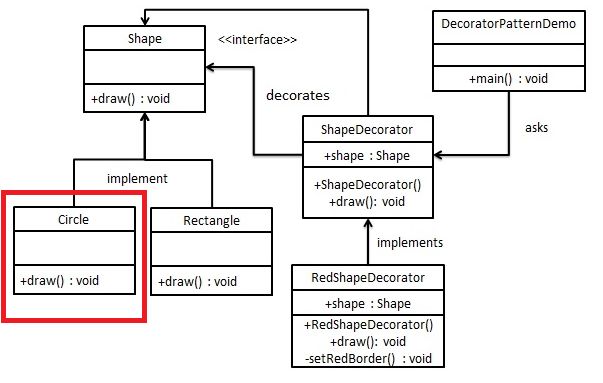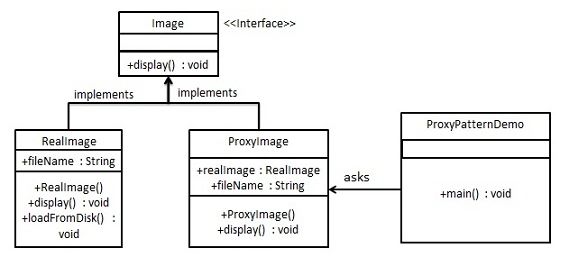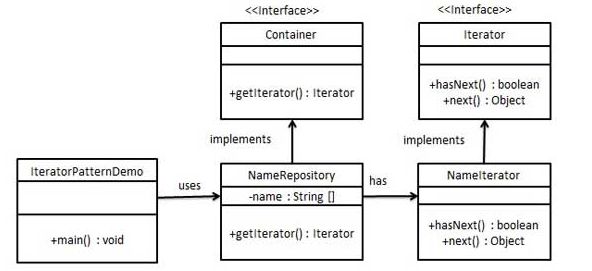设计模式之六大原则(转载) - 海 子 - 博客园
设计模式 | 菜鸟教程--------------突然发现这个写的很详细不错
代码下载:GitHub - jiajia154569836/Designpattern: 设计模式
建议:只记忆main方法推理模式中的类和接口强化记忆
工厂模式
属于创建型模式,它提供了一种创建对象的最佳方式。
优点: 1、一个调用者想创建一个对象,只要知道其名称就可以了。 2、扩展性高,如果想增加一个产品,只要扩展一个工厂类就可以。 3、屏蔽产品的具体实现,调用者只关心产品的接口。
缺点:每次增加一个产品时,需要增加一个类实现接口并且修改工厂类中的方法来new这个类。
public class FactoryPatternDemo {
public static void main(String[] args) {
ShapeFactory shapeFactory = new ShapeFactory();
//获取 Circle 的对象,并调用它的 draw 方法
Shape shape1 = shapeFactory.getShape("CIRCLE");
//调用 Circle 的 draw 方法
shape1.draw();
//获取 Rectangle 的对象,并调用它的 draw 方法
Shape shape2 = shapeFactory.getShape("RECTANGLE");
//调用 Rectangle 的 draw 方法
shape2.draw();
//获取 Square 的对象,并调用它的 draw 方法
Shape shape3 = shapeFactory.getShape("SQUARE");
//调用 Square 的 draw 方法
shape3.draw();
}
}
单例模式
属于创建型模式,它提供了一种创建对象的最佳方式。
该类负责创建自己的对象,同时确保只有单个对象被创建。
public class SingletonPatternDemo {
public static void main(String[] args) {
//不合法的构造函数
//编译时错误:构造函数 SingleObject() 是不可见的
//SingleObject object = new SingleObject();
//获取唯一可用的对象
SingleObject object = SingleObject.getInstance();
//显示消息
object.showMessage();
}
}
装饰器模式
装饰器模式(Decorator Pattern)允许向一个现有的对象添加新的功能,同时又不改变其结构。属于结构型模式。可以给shap下的任意子类添加装饰。
扩展一个类经常使用继承方式实现,由于继承为类引入静态特征,并且随着扩展功能的增多,子类会很膨胀。
public class DecoratorPatternDemo {
public static void main(String[] args) {
Shape circle = new Circle();
Shape redCircle = new RedShapeDecorator(new Circle());
Shape redRectangle = new RedShapeDecorator(new Rectangle());
System.out.println("Circle with normal border");
circle.draw();
System.out.println("\nCircle of red border");
redCircle.draw();
System.out.println("\nRectangle of red border");
redRectangle.draw();
}
}
代理模式
一个类代表另一个类的功能。这种类型的设计模式属于结构型模式。
在代理模式中,我们创建具有现有对象的对象,以便向外界提供功能接口。
public class ProxyPatternDemo {
public static void main(String[] args) {
RealImage realImage = new realImage();
Image image1 = new RealImage("test_10mb.jpg");
Image image2 = new ProxyImage("test_10mb.jpg");
image1.display();
image2.display();
}
}
策略模式
一个类的行为或其算法可以在运行时更改。这种类型的设计模式属于行为型模式。
相当于给类似操作上加了一层变成策略。
public class StrategyPatternDemo {
public static void main(String[] args) {
Context context = new Context(new OperationAdd());
System.out.println("10 + 5 = " + context.executeStrategy(10, 5));
context = new Context(new OperationSubstract());
System.out.println("10 - 5 = " + context.executeStrategy(10, 5));
context = new Context(new OperationMultiply());
System.out.println("10 * 5 = " + context.executeStrategy(10, 5));
}
}
迭代器模式
提供一种方法顺序访问一个聚合对象中各个元素, 而又无须暴露该对象的内部表示。
public class IteratorPatternDemo {
public static void main(String[] args) {
NameRepository namesRepository = new NameRepository();
for(Iterator iter = namesRepository.getIterator(); iter.hasNext();){
String name = (String)iter.next();
System.out.println("Name : " + name);
}
}}
注释: 内部类
1.内部类可以很好的实现隐藏,不允许有 private 与protected权限的,但内部类可以
2.内部类拥有外围类的所有元素的访问权限
3.可是实现多重继承
4.可以避免修改接口而实现同一个类中两种同名方法的调用。





